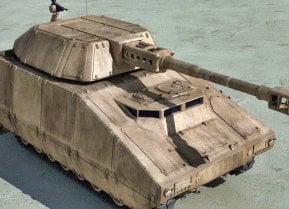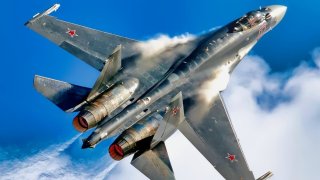Sukhoi Su-35: Russia Has Built One Truly Fast and Dangerous Fighter
The Sukhoi Su-35 (NATO reporting name "Flanker-E") has been touted as one of the most advanced 4++ generation aircraft systems, combining many fifth-generation elements.
The Sukhoi Su-35 (NATO reporting name "Flanker-E") has been touted as one of the most advanced 4++ generation aircraft systems, combining many fifth-generation elements.
The multirole supermaneuverable one-seat fighter is designed to engage air and ground threats and to counteract the enemy's naval surface forces.
The Su-35 is essentially just a heavily upgraded derivative of the Su-27 aircraft (NATO reporting name "Flanker") and was originally intended for export. However, it has been in service with the Russian Air Force since 2014 and made its first combat deployment in Syria in 2015 – where it was employed to provide cover for other Russian aircraft on bombing missions.
Designated the "Flanker-E" by NATO, this “4++ generation" fighter has proven itself to be a very capable foe to current U.S. aircraft, including the F-15 Eagle, the F/A-18 Super Hornet, and even the F-35 Lightning II. However, where the Su-27 was initially developed to address the development of the U.S. military's F-15 Eagle in the 1970s, the Su-35 was a response to the F-16.
Enter the Improved Su-27M
Development of what was to become the Su-35 began in the early 1980s, while the aircraft first flew in 1988 when it was originally known as Su-27M. It was proposed as a super agile Su-27 primarily for air superiority missions, but also with a greatly expanded air-to-ground capability.
The aircraft was proposed to serve as a replacement for the Soviet Su-27 and MiG-29 fighters, and initial production of the Su-27M commenced in 1988. It was subsequently redesignated as the Su-35 – yet according to MilitaryToday.com, just a dozen aircraft were completed for the Russian Air Force, including 9 pre-production aircraft.
Production ceased in 1995.
When it resumed, multiple improved versions emerged, including the Su-35S. The Kremlin was believed to have had 110 of the aircraft in its inventories as of December 2022. It is in service with several fighter aviation regiments of the Russian Air Force, including the 22nd Guards Fighter Aviation Regiment.
Production of the aircraft is currently underway at the Komsomolsk-on-Amur Aircraft Plant located in the Russian Far East (part of the United Aircraft Corporation within the state tech corporation Rostec), and according to Russian state media, it delivered the latest batch of Su-35S fighter jets in July.
The Su-35 is a Speedy Aircraft
While sharing broadly the blended wing-body design of the Su-27, the Su-27M/Su-35S can be visibly distinguished from the basic version by the addition of canards, which are small lifting surfaces, ahead of the wings. The Su-35's large and powerful Saturn AL-41F1S engines provide it the ability to supercruise for a long time, while it can reach supersonic speeds without using an afterburner.
The engines are also noted for employing three-dimensional thrust vectoring, which makes the Su-35 very maneuverable. Currently, it is the only production fighter to use two-plane thrust vectoring nozzles.
It has a maximum take-off weight of 34.5 tons and can accelerate to 2,500 km/h, while the Su-35 has an operational range of 1,500-4,500 km and a service ceiling of 20,000 meters. Moreover, it features supermaneuvrability capability.
More Than an Air Superiority Fighter
Though primarily an air superiority fighter, it has secondary air-to-ground capability and can carry an enormous amount of weapons. It has 12 wing and fuselage hardpoints, which allow for it to carry ordnance with a maximum weight of up to 8,000 kg (17,630 pounds), including a variety of air-to-air, air-to-surface, anti-radiation, and anti-ship missiles, as well as a number of TV, laser-, and satellite-guided bombs.
The Su-35's armament includes a GSh-30-1 30mm autocannon with 150 rounds.
In addition, the Su-35 can be equipped with an electronic warfare pod, which provides it with powerful jamming capability. It has been reported that its advanced jammers can reduce the performance of enemy radars, and can blind onboard radars found on missiles, notably the AIM-120 AMRAAM.
It is also reported to be equipped with an outstanding onboard radar control system, optical locating system, and onboard self-defense complex, while the Su-35 is capable of controlling aviation group actions in the air as well as applying the most modern guided aircraft missiles.
The pilot has two VHF/UHF encrypted radio communications systems and a jam-resistant military data link system between squadron aircraft and between the aircraft and ground control, according to Airforce-Technology.com. The navigation system is based on a digital map display with a strap-down inertial navigation system and a global positioning system.
Foreign Sales Haven't Materialized
The aircraft was initially developed as an export model of the Su-27. Several nations have been listed as potential operators including Algeria, Egypt, India, and the United Arab Emirates. However, sales of the Su-35 to those countries haven't materialized.
In 2019, Russia did complete deliveries of twenty-four Su-35 fighters to China, in a deal that was worth a reported $2.5 billion. After Beijing became the first international customer of the Su-35, the U.S. imposed sanctions on the Asian nation for breaching the congressionally mandated CAASTA (Countering America's Adversaries Through Sanctions Act). Despite that fact, the Su-35 officially entered service with the People's Liberation Army Air Force (PLAAF) in April 2018.
Author Experience and Expertise
Peter Suciu is a Michigan-based writer. He has contributed to more than four dozen magazines, newspapers, and websites with over 3,200 published pieces over a twenty-year career in journalism. He regularly writes about military hardware, firearms history, cybersecurity, politics, and international affairs. Peter is also a Contributing Writer for Forbes and Clearance Jobs. You can follow him on Twitter: @PeterSuciu.


